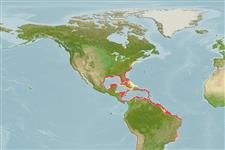>
Carangiformes (Jacks) >
Carangidae (Jacks and pompanos) > Trachinotinae
Etymology: Trachinotus: Greek, trachys, -eia, -ys = rough + Greek,noton = back (Ref. 45335).
More on author: Linnaeus.
Environment: milieu / climate zone / depth range / distribution range
Sinh thái học
Biển; Thuộc về nước lợ Cùng sống ở rạn san hô; Mức độ sâu 0 - 36 m (Ref. 3277), usually 0 - 30 m (Ref. 55175). Subtropical; 42°N - 25°S, 100°W - 30°W (Ref. 55175)
Western Atlantic: Massachusetts, USA to southeastern Brazil, including Bahamas and many of the West Indies (Ref. 7251). Reports from Africa are based on misidentifications, mostly referring to T. teraia (Ref. 81654).
Length at first maturity / Bộ gần gũi / Khối lượng (Trọng lượng) / Age
Maturity: Lm 54.7, range 48 - ? cm
Max length : 122 cm FL con đực/không giới tính; (Ref. 40637); common length : 94.0 cm FL con đực/không giới tính; (Ref. 3277); Khối lượng cực đại được công bố: 36.0 kg (Ref. 5217); Tuổi cực đại được báo cáo: 23 các năm (Ref. 42149)
Các tia vây lưng cứng (tổng cộng) : 6 - 7; Các vây lưng mềm (tổng cộng) : 18 - 21; Tia cứng vây hậu môn: 2 - 3; Tia mềm vây hậu môn: 16 - 18. Dorsal and anal fins have very long, dark anterior lobes (Ref. 26938). No scutes; a broad patch of orange-yellow on abdomen in front of anal fin; pectoral fins blackish (Ref. 13442).
Adults frequently in channels or holes, over sandy flats, around reefs, and at times over mud bottoms; usually solitary or in small schools; smaller fish tolerate brackish water. Spawn offshore (Ref. 26938). During the summer, juveniles are found in large schools especially in the surf zone along sandy beaches. Adults feed on mollusks, crabs, shrimps, and small fishes; juveniles on benthic invertebrates. Excellent food fish (Ref. 9626). Highly esteemed game fish caught on light tackle (Ref. 26938).
Robins, C.R. and G.C. Ray, 1986. A field guide to Atlantic coast fishes of North America. Houghton Mifflin Company, Boston, U.S.A. 354 p. (Ref. 7251)
IUCN Red List Status (Ref. 130435: Version 2024-1)
Threat to humans
Harmless
Human uses
Các nghề cá: Tính thương mại; Nuôi trồng thủy sản: Tính thương mại; cá để chơi: đúng; Bể nuôi cá: Bể cá công cộng
Các công cụ
Special reports
Download XML
Các nguồn internet
Estimates based on models
Preferred temperature (Ref.
123201): 23.2 - 28, mean 26.1 °C (based on 624 cells).
Phylogenetic diversity index (Ref.
82804): PD
50 = 0.5000 [Uniqueness, from 0.5 = low to 2.0 = high].
Bayesian length-weight: a=0.02884 (0.01820 - 0.04570), b=2.87 (2.74 - 3.00), in cm total length, based on LWR estimates for this species & Genus-body shape (Ref.
93245).
Mức dinh dưỡng (Ref.
69278): 4.0 ±0.2 se; based on diet studies.
Generation time: 3.9 ( na - na) years. Estimated as median ln(3)/K based on 2
growth studies.
Thích nghi nhanh (Ref.
120179): Trung bình, thời gian nhân đôi của chủng quần tối thiểu là 1.4 - 4.4 năm (tm=3; tmax=23).
Fishing Vulnerability (Ref.
59153): Moderate vulnerability (42 of 100).
Nutrients (Ref.
124155): Calcium = 23.2 [8.6, 45.2] mg/100g; Iron = 0.618 [0.318, 1.376] mg/100g; Protein = 20.7 [18.6, 22.7] %; Omega3 = 0.167 [0.087, 0.331] g/100g; Selenium = 19 [8, 47] μg/100g; VitaminA = 11.6 [2.6, 53.6] μg/100g; Zinc = 0.494 [0.296, 0.798] mg/100g (wet weight);
